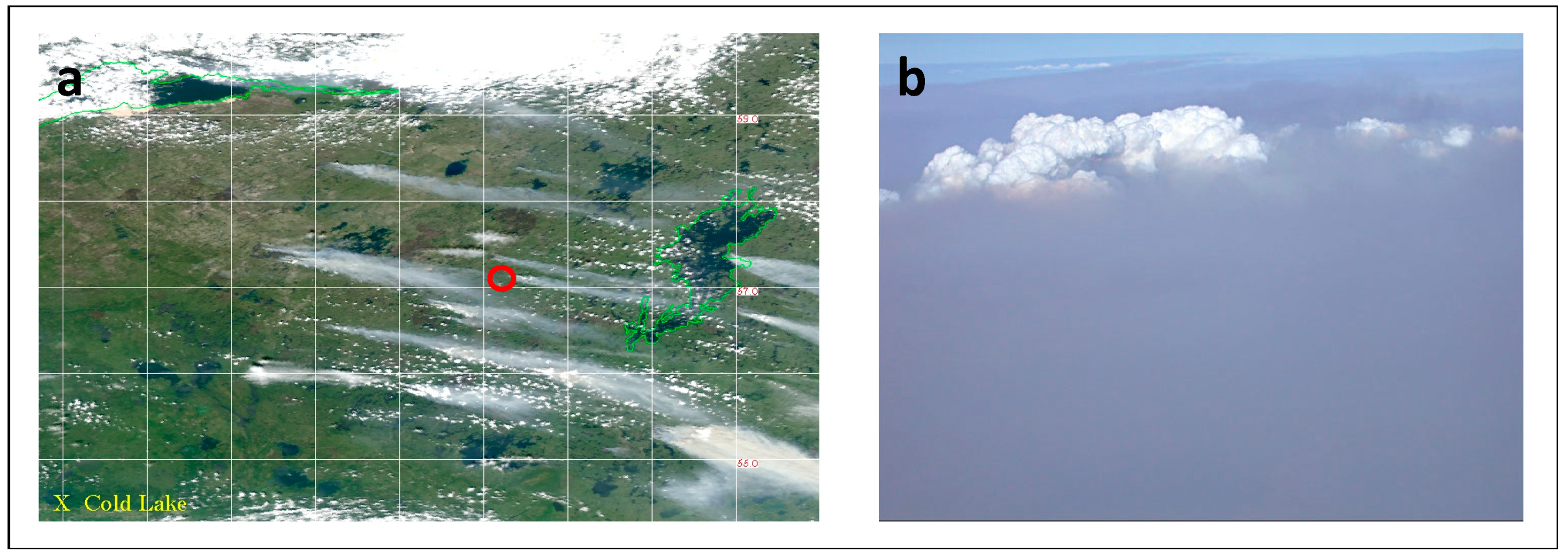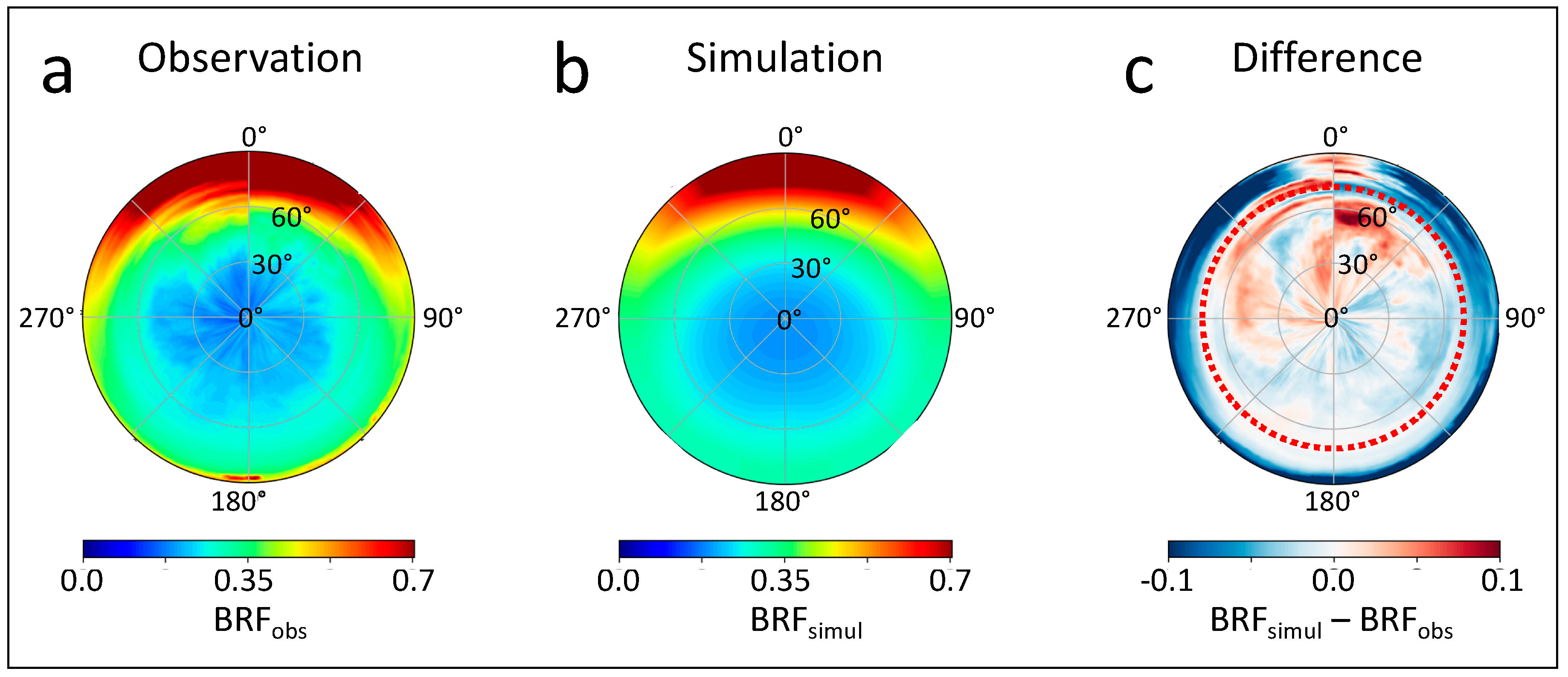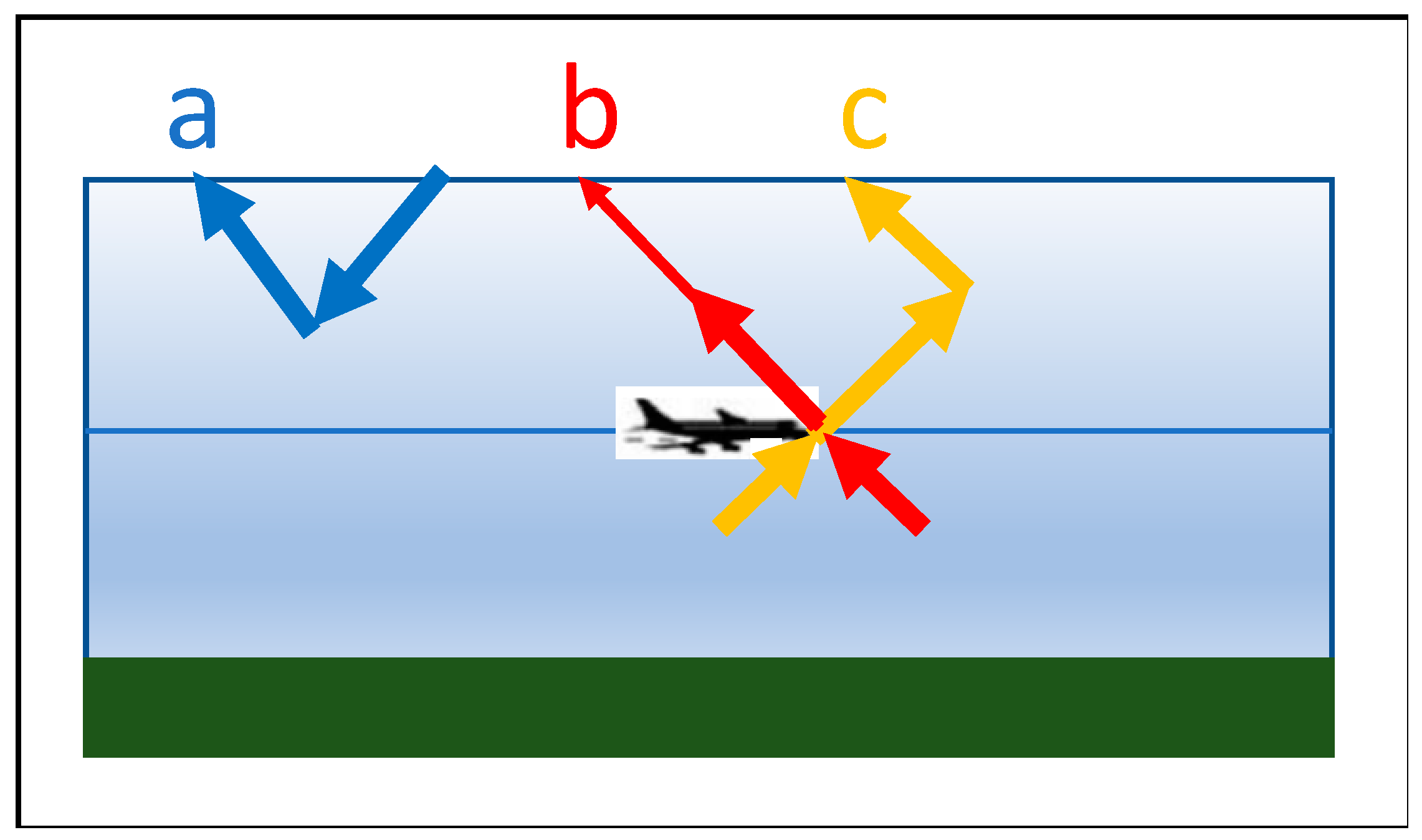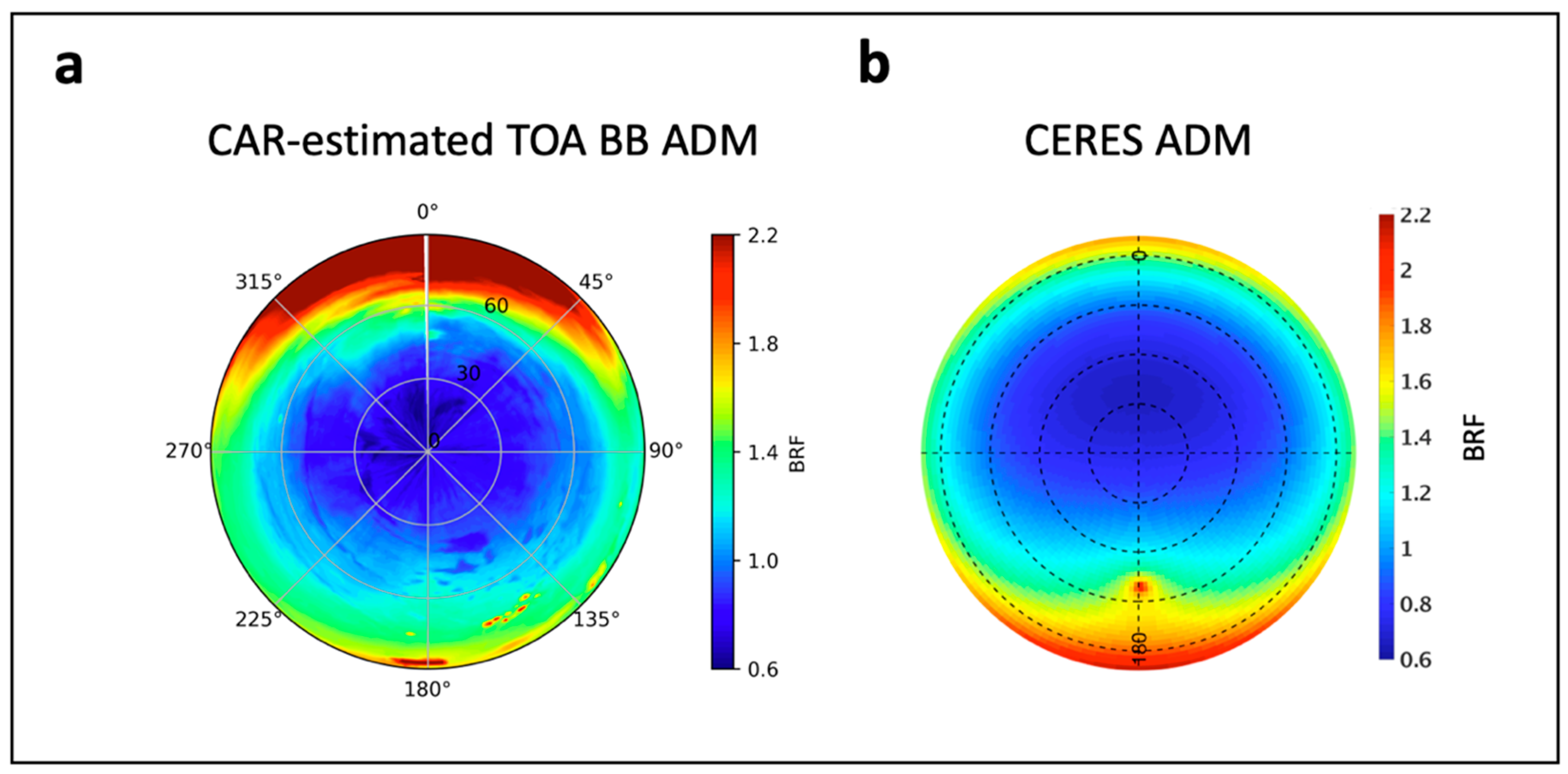Developing an Aircraft-Based Angular Distribution Model of Solar Reflection from Wildfire Smoke to Aid Satellite-Based Radiative Flux Estimation
Abstract
:1. Introduction
2. Materials and Methods
2.1. Airborne Observations
2.2. Simulations
3. Results and Discussions
3.1. Scene Characterization
3.2. Broadband Top-of-Atmosphere Angular Model
3.3. Sensitivity of the Angular Model to Variations in Scene Parameters
4. Conclusions
Author Contributions
Funding
Acknowledgments
Conflicts of Interest
References
- Mouillot, F.; Narasimha, A.; Balkanski, Y.; Lamarque, J.F.; Field, C.B. Global carbon emissions from biomass burning in the 20th century. Geophys. Res. Lett. 2006, 33, L01801. [Google Scholar] [CrossRef]
- Marlon, J.R.; Bartlein, P.J.; Carcaillet, C.; Gavin, D.G.; Harrison, S.P.; Higuera, P.E.; Joos, F.; Power, M.J.; Prentice, I.C. Climate and human influences on global biomass burning over the past two millenia. Nat. Geosci. 2008, 1, 697–702. [Google Scholar] [CrossRef]
- Spracklen, D.V.; Mickley, L.J.; Logan, J.A.; Hudman, R.C.; Yevich, R.; Flannigan, M.D.; Westerling, A.L. Impacts of climate change from 2000 to 2050 on wildfire activity and carbonaceous aerosol concentrations in the western United States. J. Geophys. Res. 2009, 114, D20301. [Google Scholar] [CrossRef]
- Kloster, S.; Mahowald, N.M.; Randerson, J.T.; Thornton, P.E.; Hoffman, F.M.; Levis, S.; Lawrence, P.J.; Feddema, J.J.; Oleson, K.W.; Lawrence, D.M. Fire dynamics during the 20th century simulated by the Community Land Model. Biogeosciences 2010, 7, 1877–1902. [Google Scholar] [CrossRef] [Green Version]
- Pechony, O.; Shindell, D.T. Driving forces of global wildfires over the past millennium and the forthcoming century. Proc. Natl. Acad. Sci. USA 2010, 107, 19167–19170. [Google Scholar] [CrossRef] [Green Version]
- IPCC. Climate Change 2013: The Physical Science Basis. Contribution of Working Group I to the Fifth Assessment Report of the Intergovernmental Panel on Climate Change; Stocker, T.F., Qin, D., Plattner, G.-K., Tignor, M., Allen, S.K., Boschung, J., Nauels, A., Xia, Y., Bex, V., Midgley, P.M., Eds.; Cambridge University Press: Cambridge, UK; New York, NY, USA, 2013; p. 1535. [Google Scholar] [CrossRef]
- Wielicki, B.A.; Barkstrom, B.R.; Harrison, E.F.; Lee, R.B.; Smith, G.L.; Cooper, J.E. Clouds and the Earth’s Radiant Energy System (CERES): An earth observing system experiment. Bull. Am. Meteorol. Soc. 1996, 77, 853–868. [Google Scholar] [CrossRef]
- Loeb, N.G.; Parol, F.; Buriez, J.C.; Vanbauce, C. Top-of-atmosphere albedo estimation from angular distribution models using scene identification from satellite cloud property retrievals. J. Clim. 2000, 13, 1269–1285. [Google Scholar] [CrossRef]
- Loeb, N.G.; Kato, S.; Loukachine, K.; Manalo-Smith, N. Angular distribution models for top-of-atmosphere radiative flux estimation from the Clouds and the Earth’s Radiant Energy System instrument on the Terra satellite. Part I: Methodology. J. Atmos. Ocean. Technol. 2005, 22, 338–351. [Google Scholar] [CrossRef]
- Su, W.; Corbett, J.; Eitzen, Z.; Liang, L. Next-generation angular distribution models for top-of-atmosphere radiative flux calculation from CERES instruments: Methodology. Atmos. Meas. Tech. 2015, 8, 611–632. [Google Scholar] [CrossRef]
- Lucht, W.; Schaaf, C.B.; Strahler, A.H. An algorithm for the retrieval of albedo from space using semiempirical BRDF models. IEEE Trans. Geosci. Remote Sens. 2000, 38, 977–998. [Google Scholar] [CrossRef] [Green Version]
- Penner, J.E.; Dickinson, R.E.; O’Neill, C.A. Effects of aerosol from biomass burning on the global radiation budget. Science 1992, 256, 1432–1434. [Google Scholar] [CrossRef] [PubMed]
- Kaufman, Y.J.; Fraser, R.S. The effect of smoke particles on clouds and climate forcing. Science 1997, 277, 1636–1639. [Google Scholar] [CrossRef]
- Christopher, S.A.; Wang, M.; Berendes, T.A.; Welch, R.M.; Yang, S.K. The 1985 biomass burning season in South America: Satellite remote sensing of fires, smoke and regional radiative energy budgets. J. Appl. Meteorol. 1998, 37, 661–678. [Google Scholar] [CrossRef]
- Li, X.; Christopher, S.A.; Chou, J.; Welch, R.M. Estimation of shortwave direct radiative forcing of biomass-burning aerosols using new angular models. J. Appl. Meteorol. 2000, 39, 2278–2291. [Google Scholar] [CrossRef]
- Ramaswamy, R.; Kiehl, J.T. Sensitivities of the radiative forcing due to large loadings of smoke and dust aerosols. J. Geophys. Res. 1985, 90, 5597–5613. [Google Scholar] [CrossRef]
- Patadia, F.; Christopher, S.A.; Zhang, J. Development of empirical angular distribution models for smoke aerosols: Methods. J. Geophys. Res. 2011, 116, D14203. [Google Scholar] [CrossRef]
- Lyapustin, A.; Gatebe, C.K.; Kahn, R.; Brandt, R.; Redemann, J.; Russell, P.; King, M.D.; Pedersen, C.A.; Gerland, S.; Poudyal, R.; et al. Analysis of snow BRF from ARCTAS Spring-2008 campaign. Atmos. Chem. Phys. 2010, 10, 4359–4375. [Google Scholar] [CrossRef]
- Gatebe, C.K.; King, M.D. Airborne spectral BRDF of various surface types (ocean, vegetation, snow, desert, wetlands, cloud decks, smoke layers) for remote sensing applications. Remote Sens. Environ. 2016, 179, 131–148. [Google Scholar] [CrossRef]
- Nag, S.; Gatebe, C.K.; Hilker, T. Simulation of multiangular remote sensing products using small satellite formations. IEEE J. Sel. Top. Appl. Earth Obs. Remote Sens. 2016, 10, 638–653. [Google Scholar] [CrossRef]
- Jacob, D.J.; Crawford, J.H.; Maring, H.; Dibb, J.E.; Clarke, A.D.; Ferrare, R.A.; Hostetler, C.A.; Russell, P.B.; Singh, H.B.; Thompson, A.M.; et al. The arctic research of the composition of the troposphere from aircraft and satellites (ARCTAS) mission: Design, execution, and first results. Atmos. Chem. Phys. 2010, 10, 5191–5212. [Google Scholar] [CrossRef]
- Russell, P.B.; Livingston, J.M.; Hignett, P.; Kinne, S.; Wong, J.; Hobbs, P.V. Aerosol-induced radiative flux changes off the United States Mid-Atlantic coast: Comparison of values calculated from sunphotometer and in situ data with those measured by airborne pyranometer. J. Geophys. Res. 1999, 104, 2289–2307. [Google Scholar] [CrossRef]
- Clarke, A.; McNaughton, C.; Kapustin, V.; Shinozuka, Y.; Howell, S.; Dibb, J.; Zhou, J.; Anderson, B.; Brekhovskikh, V.; Turner, H.; et al. Biomass burning and pollution aerosol over North America: Organic components and their influence on spec-tral optical properties and humidification response. J. Geophys. Res. 2007, 112, D12S18. [Google Scholar] [CrossRef]
- Pilewskie, P.; Pommier, J.; Bergstrom, R.; Gore, W.; Howard, S.; Rabbette, M.; Schmid, B.; Hobbs, P.V.; Tsay, S.C. Solar spectral radiative forcing during the Southern African Regional Science Initiative. J. Geophys. Res. 2003, 108, 8486. [Google Scholar] [CrossRef]
- Bucholtz, A.; Naval Research Laboratory, Monterey, CA, USA. Personal communication, 2008.
- Gatebe, C.K.; Várnai, T.; Poudyal, R.; Ichoku, C.M.; King, M.D. Taking the pulse of pyrocumulus clouds. Atmos. Environ. 2012, 52, 121–130. [Google Scholar] [CrossRef] [Green Version]
- Roberts, G.; Nenes, A. A continuous-flow streamwise thermal-Gradient CCN chamber for atmospheric measurements. Aerosol Sci. Technol. 2005, 39, 206–221. [Google Scholar] [CrossRef]
- Lance, S.; Medina, J.; Smith, J.N.; Nenes, A. Mapping the operation of the DMT continuous flow CCN counter. Aerosol Sci. Technol. 2006, 40, 242–254. [Google Scholar] [CrossRef]
- Strawa, A.W.; Provencal, R.; Owano, T.; Kirschstetter, T.W.; Hallar, G.; Williams, M.B. Aero3X: Fast, accurate measurement of aerosol optical properties for climate and air quality studies. In Proceedings of the American Geophysical Union, Fall Meeting 2007, San Francisco, CA, USA, 10–14 December 2007; abstract #A53G-03. Available online: https://ui.adsabs.harvard.edu/abs/2007AGUFM.A53G..03S/abstract (accessed on 24 June 2019).
- Provencal, R.; Gupta, M.; Owano, T.G.; Baer, D.S.; Ricci, K.N.; O’Keefe, A.; Podolske, J.R. Cavity-enhanced quantum-cascade laser-based instrument for carbon monoxide measurements. Appl. Opt. 2005, 44, 6712–6717. [Google Scholar] [CrossRef] [PubMed] [Green Version]
- Barrick, J.D.; Aknan, A.A. P-3B Supporting Measurements Data System (PDS). 2008. Available online: http://www.espo.nasa.gov/arctas/docs/instruments/pds.pdf (accessed on 24 June 2019).
- Shinozuka, Y.; Redemann, J.; Livingston, J.M.; Russell, P.B.; Clarke, A.; Howell, S.; Freitag, S.; O’Neill, N.T.; Reid, E.A.; Johnson, R.R.; et al. Airborne observation of aerosol optical depth during ARCTAS: Vertical profiles, inter-comparison and fine-mode fraction. Atmos. Chem. Phys. 2011, 11, 3673–3688. [Google Scholar] [CrossRef]
- Virkkula, A. Correction of the calibration of the 3-wavelength Particle Soot Absorption Photometer (3λ PSAP). Aerosol Sci. Technol. 2010, 44, 706–712. [Google Scholar] [CrossRef]
- Abdou, W.A.; Pilorz, S.H.; Helmlinger, M.C.; Conel, J.E.; Diner, D.J.; Bruegge, C.J.; Martonchik, J.V.; Gatebe, C.K.; King, M.D.; Hobbs, P.V. Sua pan surface bidirectional reflectance: A case study to evaluate the effect of atmospheric correction on the surface products of the Multi-angle Imaging SpectroRadiometer (MISR) during SAFARI 2000. IEEE Trans. Geosci. Remote Sens. 2006, 44, 1699–1706. [Google Scholar] [CrossRef]
- Román, M.O.; Gatebe, C.K.; Poudyal, R.; Schaaf, C.B.; Wang, Z.; King, M.D. Variability in surface BRDF at different spatial scales (30 m-500 m) over a mixed agricultural landscape as retrieved from airborne and satellite spectral measurements. Remote Sens. Environ. 2011, 115, 2184–2203. [Google Scholar] [CrossRef]
- Gatebe, C.K.; Butler, J.J.; Cooper, J.W.; Kowalewski, M.; King, M.D. Characterization of errors in the use of integrating-sphere systems in the calibration of scanning radiometers. Appl. Opt. 2007, 46, 31–7640. [Google Scholar] [CrossRef]
- Gatebe, C.K.; King, M.D.; Poudyal, R. CAR Arctic Research of the Composition of the Troposphere from Aircraft and Satellites; Goddard Earth Sciences Data and Information Services Center (GES DISC): Greenbelt, MD, USA, 2018.
- Mayer, B.; Kylling, A. Technical note: The libRadtran software package for radiative transfer calclations—description and examples of use. Atmos. Chem. Phys. 2005, 5, 1855–1877. [Google Scholar] [CrossRef]
- Emde, C.; Buras-Schnell, R.; Kylling, A.; Mayer, B.; Gasteiger, J.; Hamann, U.; Kylling, J.; Richter, B.; Pause, C.; Dowling, T.; et al. The libRadtran software package for radiative transfer calculations (version 2.0.1). Geosci. Model Dev. 2016, 9, 1647–1672. [Google Scholar] [CrossRef] [Green Version]
- Kato, S.; Ackerman, T.P.; Mather, J.H.; Clothiaux, E. The k–distribution method and correlated–k approximation for a shortwave radiative transfer model. J. Quantif. Spectrosc. Radiat. Transf. 1999, 62, 109–121. [Google Scholar] [CrossRef]
- Gautam, R.; Gatebe, C.K.; Singh, M.K.; Várnai, T.; Poudyal, R. Radiative characteristics of clouds embedded in smoke derived from airborne multi- angular measurements. J. Geophys. Res. 2016, 121, 9140–9152. [Google Scholar] [CrossRef]
- Levy, R.C.; Remer, L.A.; Dubovik, O. Global aerosol optical properties and application to Moderate Resolution Imaging Spectroradiometer aerosol retrieval over land. J. Geophys. Res. 2007, 112, D13210. [Google Scholar] [CrossRef]
- Schaaf, C.; Wang, Z. MCD43C1 MODIS/Terra+Aqua BRDF/AlbedoModel parameters daily l3 global 0.05Deg CMG V006. NASA EOSDIS Land Process. DAAC 2015. [Google Scholar] [CrossRef]
- Baldridge, A.M.; Hook, S.J.; Grove, C.I.; Rivera, G. The ASTER spectral library version 2.0. Remote Sens. Environ. 2009, 113, 711–715. [Google Scholar] [CrossRef]
- Dubovik, O.; Holben, B.N.; Kaufman, Y.J.; Yamasoe, M.; Smirnov, A.; Tanré, D.; Slutsker, I. Single-scattering albedo of smoke retrieved from the sky radiance and solar transmittance measured from ground. J. Geophys. Res. 1998, 103, 31903–31923. [Google Scholar] [CrossRef]
- Eck, T.F.; Holben, B.N.; Reid, J.S.; O’Neill, N.T.; Schafer, J.S.; Dubovik, O.; Smirnov, A.; Yamasoe, M.A.; Artaxo, P. High aerosol optical depth biomass burning events: A comparison of optical properties for different source regions. Geophys. Res. Lett. 2003, 30, 2035. [Google Scholar] [CrossRef]
- Park, Y.H.; Sokolik, I.N.; Hall, S.R. The impact of smoke on the ultraviolet and visible radiative forcing under different fire regimes. Air Soil Water Res. 2018, 11. [Google Scholar] [CrossRef]
- Sun, W.; Loeb, N.G.; Davies, R.; Loukachine, K.; Miller, W.F. Comparison of MISR and CERES top-of-atmosphere albedo. Geophys. Res. Lett. 2006, 33, L23810. [Google Scholar] [CrossRef]
- Buriez, J.-C.; Parol, F.; Poussi, Z.; Viollier, M. An improved derivation of the top-of-atmosphere albedo from POLDER/ADEOS-2: 2. Broadband albedo. J. Geophys. Res. 2007, 112, D19201. [Google Scholar] [CrossRef]
- Wen, G.; Tsay, S.-C.; Cahalan, R.F.; Oreopoulos, L. Path radiance technique for retrieving aerosol optical thickness over land. J. Geophys. Res. 1999, 104, 31321–31332. [Google Scholar] [CrossRef] [Green Version]
- Penndorf, R. Tables of the refractive index for standard air and the Rayleigh scattering coefficient for the spectral region between 0.2 and 20.0 μ and their application to atmospheric optics. J. Opt. Soc. Am. 1957, 47, 176–182. [Google Scholar] [CrossRef]
- Maignan, F.; Bréon, F.-M.; Lacaze, R. Bidirectional reflectance of earth targets: Evaluation of analytical models using a large set of spaceborne measurements with emphasis on the Hot Spot. Remote Sens. Environ. 2004, 90, 210–220. [Google Scholar] [CrossRef]






| Acronym | Meaning |
|---|---|
| 3D | Three-dimensional |
| AATS | Ames Airborne Tracking Sunphotometer |
| ADM | Angular distribution model |
| AOD | Aerosol optical depth |
| ARCTAS | Arctic Research of the Composition of the Troposphere from Aircraft and Satellites |
| ASTER | Advanced Spaceborne Thermal Emission and Reflection Radiometer |
| BRF | Bidirectional reflectance factor |
| CAR | Cloud Absorption Radiometer |
| CERES | Clouds and the Earth’s Radiant Energy System |
| CMF | Coarse mode fraction |
| DISORT | Discrete Ordinates Radiative Transfer |
| EOSDIS | Earth Observing System Data and Information System |
| fsfc | Factor for surface parameters |
| IR | Infrared |
| libRadtran | Library for radiative transfer |
| MODIS | Moderate Resolution Imaging Spectroradiometer |
| NASA | National Aeronautics and Space Administration |
| NDVI | Normalized Difference Vegetation Index |
| PSAP | Particle Soot Absorption Photometer |
| RMS | Root-mean-square |
| RTLS | Ross-Thick-Li-Sparse |
| S | Spectral slope parameter |
| SSA | Single scattering albedo |
| TOA | Top-of-atmosphere |
| UTC | Coordinated Universal Time |
| Parameter | Range |
|---|---|
| AOD550 nm | 3–6 |
| SSA550 nm | 0.888–0.912 |
| S | 0.2–2.7 |
| fsfc | 0.3–4.5 |
| CMF | 0.13–0.28 |
| SZA | 50°–56°1 |
© 2019 by the authors. Licensee MDPI, Basel, Switzerland. This article is an open access article distributed under the terms and conditions of the Creative Commons Attribution (CC BY) license (http://creativecommons.org/licenses/by/4.0/).
Share and Cite
Várnai, T.; Gatebe, C.; Gautam, R.; Poudyal, R.; Su, W. Developing an Aircraft-Based Angular Distribution Model of Solar Reflection from Wildfire Smoke to Aid Satellite-Based Radiative Flux Estimation. Remote Sens. 2019, 11, 1509. https://doi.org/10.3390/rs11131509
Várnai T, Gatebe C, Gautam R, Poudyal R, Su W. Developing an Aircraft-Based Angular Distribution Model of Solar Reflection from Wildfire Smoke to Aid Satellite-Based Radiative Flux Estimation. Remote Sensing. 2019; 11(13):1509. https://doi.org/10.3390/rs11131509
Chicago/Turabian StyleVárnai, Tamás, Charles Gatebe, Ritesh Gautam, Rajesh Poudyal, and Wenying Su. 2019. "Developing an Aircraft-Based Angular Distribution Model of Solar Reflection from Wildfire Smoke to Aid Satellite-Based Radiative Flux Estimation" Remote Sensing 11, no. 13: 1509. https://doi.org/10.3390/rs11131509






